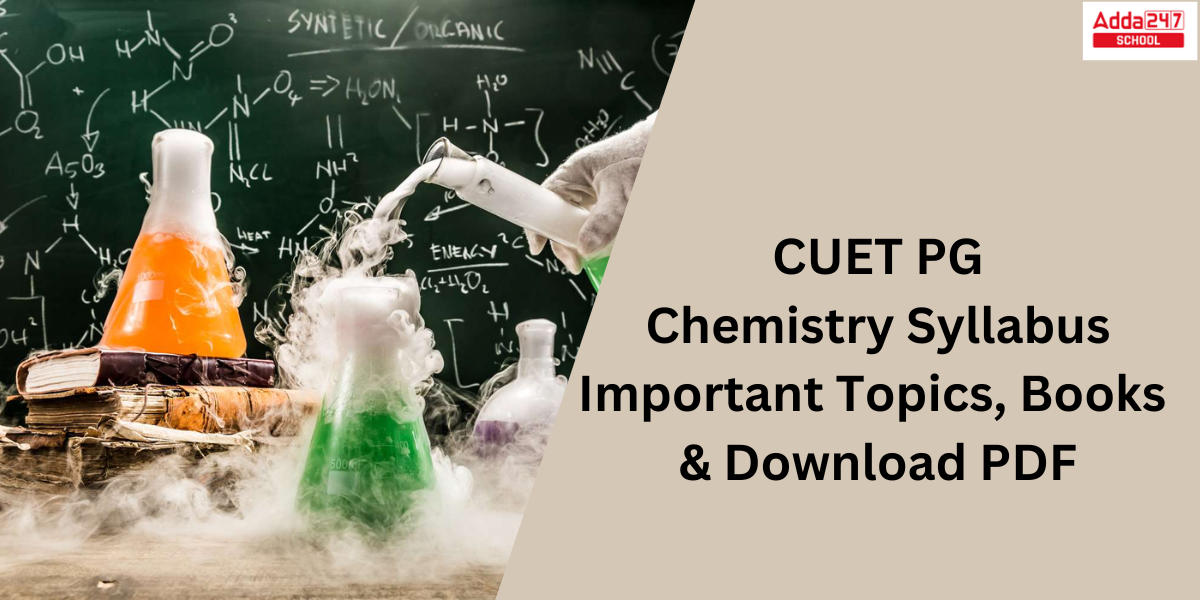The National Testing Agency releases the CUET PG Chemistry Syllabus 2025 on its official website at pgcuet.samarth.ac.in.The CUET PG Chemistry syllabus focuses on inorganic, organic, and physical chemistry. To perform well on the CUET PG exam, candidates must fully comprehend the Chemistry syllabus of CUET PG 2025. Candidates interested in pursuing a PG course in chemistry should carefully review the CUET PG Chemistry syllabus 2025, which is given on this page.
CUET PG Chemistry Syllabus 2025
Master in Chemistry is one of the most popular courses among students that enables a wide range of career opportunities. The CUET PG Chemistry syllabus 2025 outlines the subjects and ideas that will be covered on the Chemistry test. Candidates studying for the CUET PG 2025 MSc Chemistry should begin their preparation in accordance with the syllabus. By studying from the syllabus, you may ensure that you have covered all of the necessary information, increasing your chances of admission to the selected university/college.
CUET PG 2025 Chemistry Syllabus: Overview
The Common University Entrance Test (CUET PG ) is a national-level entrance exam for students applying to postgraduate studies at participating universities. Aspirants preparing for the CUET PG 2025 Chemistry test should begin their preparation as soon as possible in order to pass the exam and gain admission to their preferred college or university. Check out the CUET PG 2025 Chemistry Syllabus and Exam Pattern in the table below.
| CUET PG Chemistry Syllabus Overview | |
|
Name of the Exam
|
Common University Entrance Test for Postgraduate programmes
|
|
Exam Conducting Body
|
National Testing Agency
|
|
Mode of the examination
|
Computer-based test (CBT)
|
|
Medium/ Language
|
English and Hindi
|
|
Duration of the examination
|
105 Minutes |
|
Frequency of exams in a year
|
Once a year |
|
Types of questions
|
Multiple Choice Questions (MCQs)
|
| CUET PG Chemistry Subject code | SCQP08 |
|
Total number of Questions
|
75 |
|
Name of the sections
|
Domain-Specific Questions
|
| Total Marks | 300 |
|
Negative marking
|
Yes |
| Marking Scheme |
|
| Official Website | pgcuet.samarth.ac.in. |
CUET PG Chemistry Syllabus PDF Download
The CUET PG Chemistry Syllabus comprises all of the major disciplines and subjects that will be tested in the CUET PG exam. Candidates wishing to take the CUET PG Chemistry test can get the CUET PG Chemistry Syllabus 2025 PDF from the official website via the link provided below.
CUET PG Chemistry Syllabus PDF Download
CUET MSc Chemistry Syllabus 2025
The CUET MSc Chemistry syllabus 2025 contains the topics covered in the UG Chemistry course. The Chemistry Syllabus for CUET PG is broken into three sections: Organic Chemistry, Physical Chemistry, and Inorganic Chemistry. Explore the detailed section-wise CUET PG Chemistry Syllabus 2025 provided below.
CUET PG Chemistry syllabus: Physical Chemistry
Check out the Topics and Subjects included in the CUET PG Syllabus for Physical Chemistry below.
Gaseous State
Behavior of real gases: Deviations from ideal gas behavior, compressibility factor, and its variation with pressure for different gases. Causes of deviation from ideal behavior. van der Waals equation of state, its derivation and application in explaining real gas behaviour; van der Waals equation expressed in virial form, Boyle temperature. Isotherms of real gases and their comparison with van der Waals isotherms, continuity of states, critical state, critical and van der Waals constants, law of corresponding states.
Kinetic molecular model of a gas: postulates and derivation of the kinetic gas equation; collision frequency; collision diameter; mean free path and viscosity of gases, including their temperature and pressure dependence, relation between mean free path and coefficient of viscosity, calculation of σ from η; variation of viscosity with temperature and pressure. Maxwell distribution and its use in evaluating molecular velocities (average, root mean square and most probable) and average kinetic energy, law of equipartition of energy, degrees of freedom and molecular basis of heat capacities.
Liquid State
Structure and physical properties of liquids; vapour pressure, surface tension, viscosity, and their dependence on temperature, Effect of addition of various solutes on surface tension, cleansing action of detergents. Structure of water.
Ionic Equilibria
Strong, moderate and weak electrolytes, degree of ionization, factors affecting degree of ionization, ionization constant and ionic product of water. Ionization of weak acids and bases, pH scale, common ion effect; dissociation constants of mono-, di- and tri-protic acids. Salt hydrolysis, hydrolysis constants, degree of hydrolysis and pH for different salts. Buffer solutions; Henderson equation, buffer capacity, buffer range, buffer action, applications of buffers in analytical chemistry, Solubility and solubility product. Brönsted-Lowry concept of acid-base reactions, solvated proton, relative strength of acids, types of acid-base reactions, levelling solvents, Lewis acid-base concept, Classification of Lewis acids, Hard and Soft Acids and Bases (HSAB) Application of HSAB principle. Qualitative treatment of acid – base titration curves (calculation of pH at various stages). Theory of indicators; selection of indicators and their limitations. Multistage equilibria in polyelectrolyte.
Solid State
Nature of the solid state, law of constancy of interfacial angles, law of rational indices, Miller indices, elementary ideas of symmetry, symmetry elements and symmetry operations, qualitative idea of point and space groups, seven crystal systems and fourteen Bravais lattices; X-ray diffraction, Bragg’s law, a simple account of rotating crystal method and powder pattern method. Analysis of powder diffraction patterns of NaCl, CsCl and KCl. Various types of defects in crystals, Glasses and liquid crystals.
Thermodynamics
Intensive and extensive variables; state and path functions; isolated, closed and open systems; zeroth law of thermodynamics. First law: Concept of heat, q, work, w, internal energy, U, and statement of first law; enthalpy, H, relation between heat capacities, calculations of q, w, U and H for reversible, irreversible and free expansion of gases (ideal and van der Waals) under isothermal and adiabatic conditions.
Thermochemistry
Heats of reactions: standard states; enthalpy of formation of molecules and ions and enthalpy of combustion and its applications; calculation of bond energy, bond dissociation energy and resonance energy from thermochemical data, effect of temperature (Kirchhoff’s equations), and pressure on the enthalpy of reactions.
Second Law:
Concept of entropy; thermodynamic scale of temperature, statement of the second law of thermodynamics; molecular and statistical interpretation of entropy. Calculation of entropy change for reversible and irreversible processes.
Third law of thermodynamics:
Third Law of thermodynamics, residual entropy, calculation of absolute entropy of molecules.
Free Energy Functions:
Gibbs and Helmholtz energy; variation of S, G, A with T, V, P; Free energy change and spontaneity. Relation between Joule-Thomson coefficient and other thermodynamic parameters; inversion temperature; Gibbs-Helmholtz equation; Maxwell relations; thermodynamic equation of state. Partial molar quantities Partial molar quantities, dependence of thermodynamic parameters on composition; Gibbs Duhem equation, chemical potential of ideal mixtures, change in thermodynamic functions in mixing of ideal gases.
Dilute solutions or Colligative Properties
Dilute solutions; lowering of vapour pressure, Raoult’s and Henry’s Laws and their applications. Excess thermodynamic functions. Thermodynamic derivation using chemical potential to derive relations between the four colligative properties: [(i) relative lowering of vapour pressure, (ii) elevation of boiling point, (iii) Depression of freezing point, (iv) osmotic pressure] and amount of solute. Applications in calculating molar masses of normal, dissociated and associated solutes in solution.
Molecular Spectroscopy & Photochemistry
Unit-I
Interaction of electromagnetic radiation with molecules and various types of spectra; Born Oppenheimer approximation. Rotation spectroscopy: Selection rules, intensities of spectral lines, determination of bond lengths of diatomic and linear triatomic molecules, isotopic substitution. Vibrational spectroscopy: Classical equation of vibration, computation of force constant, amplitude of
diatomic molecular vibrations, anharmonicity, Morse potential, dissociation energies, fundamental frequencies, overtones, hot bands, degrees of freedom for polyatomic molecules, modes of vibration, concept of group frequencies. Vibration-rotation spectroscopy: diatomic vibrating rotator, P, Q, R branches.
Unit-II
Raman spectroscopy: Qualitative treatment of Rotational Raman effect; Effect of nuclear spin, Vibrational Raman spectra, Stokes and anti-Stokes lines; their intensity difference, rule of mutual exclusion. Electronic spectroscopy: Franck-Condon principle, electronic transitions, singlet and triplet states, fluorescence and phosphorescence, dissociation and predissociation.
Unit-III
Photophysical and photochemical processes: laws of photochemistry, quantum yield. Jablonski diagrams: Franck-Condon principle, Law of photochemical equivalence, quantum efficiency, low and high quantum efficiency. kinetics of photochemical reactions (H2 + Br2⇌HBr, 2HI ⇌ H2 + I2), energy transfer in photochemical reactions (photosensitization and quenching), fluorescence, phosphorescence, chemiluminescence, Discussion of Electronic spectra and photochemistry (Lambert-Beer law and its applications).
Chemical Kinetics
Order and molecularity of a reaction, rate laws in terms of the advancement of a reaction, differential and integrated rate laws for first, second and fractional order reactions, pseudounimolecular reactions, determination of the order, kinetics of complex reactions (limited to first order): (i) Opposing reactions (ii) parallel reactions and (iii) consecutive reactions and their differential rate equations (steady-state approximation in reaction mechanisms) (iv) chain reactions. Temperature dependence of reaction rates; Arrhenius equation; activation energy. Collision theory of reaction rates, Lindemann mechanism, qualitative treatment of the theory of absolute reaction rates.
Catalysis
Types of catalyst, specificity and selectivity, mechanisms of catalyzed reactions at solid surfaces; effect of particle size and efficiency of nanoparticles as catalysts. Enzyme catalysis, MichaelisMenten mechanism, acid-base catalysis.
Surface chemistry
Physical adsorption, chemisorption, adsorption isotherms (Freundlich, Temkin, Derivation of Langumuir adsorption isotherms, surface area determination), BET theory of multilayer adsorption (no derivation), Adsorption in solution.
Phase Equilibria
Concept of phases, components and degrees of freedom, derivation of Gibbs Phase Rule for nonreactive and reactive systems; Clausius-Clapeyron equation and its applications to solid-liquid, liquid-vapor and solid-vapor equilibria, the phase diagram for one component systems, with applications. Phase diagrams for systems of solid-liquid equilibria involving eutectic, congruent and incongruent melting points, solid solutions. Three-component systems, water chloroform-acetic acid system, triangular plots. Binary solutions: Gibbs-Duhem-Margules equation, its derivation and applications to fractional distillation of binary miscible liquids (ideal and nonideal), azeotropes, lever rule, partial miscibility of liquids, CST, miscible pairs, steam distillation. Nernst distribution law: its derivation and applications.
Introduction to Quantum Chemistry:
Unit-I
Introduction to black-body radiation and distribution of energy, photo-electic effect, concept of quantization, wave particle duality (de-Broglie’s hypothesis), The uncertainty principle, The wave function: wave function and its interpretation, conditions of normalization and Orthogonality and its significance. Basic idea about operators, eigen function and values, Schrodinger equation and application to free-particle and particle in a box, boundary conditions, wave functions and energies, degeneracy, hydrogen atom, Schrodinger equation in polar coordinates, radial and angular parts of the hydrogenic orbitals, degeneracies, spherical harmonics, representations of hydrogenic orbitals.
Unit-II
Quantitative treatment of simple harmonic osciallator model, setting up of Schodinger equation and discussion of solution of wave functions. Rigid rotator model and discussion of application of Schrodinger equation. idea about transformation to spherical polar coordinate, discussion on solution.
Unit-III
Qualitative treatment of hydrogen atom and hydrogen-like ions: setting up of Schrödinger equation in spherical polar coordinates, radial part, quantization of energy (only final energy expression). Average and most probable distances of electron from nucleus. Valence bond and molecular orbital approaches, LCAO-MO treatment of H2, H2 + ; bonding and anti-bonding orbitals, Comparison of LCAO-MO and VB treatments of H2 (only wavefunctions, detailed solution not required) and their limitations.
Conductance
Arrhenius theory of electrolytic dissociation. Conductivity, equivalent and molar conductivity and their variation with dilution for weak and strong electrolytes. Molar conductivity at infinite dilution. Kohlrausch law of independent migration of ions. Debye-Hückel-Onsager equation, Wien effect, DebyeFalkenhagen effect, Walden’s rules. Ionic velocities, mobilities and their determinations, transference numbers and their relation to ionic mobilities, determination of transference numbers using Hittorf and Moving Boundary methods. Applications of conductance measurement: (i) degree of dissociation of weak electrolytes, (ii) ionic product of water (iii) solubility and solubility product of sparingly soluble salts, (iv) conductometric titrations, and (v) hydrolysis constants of salts.
Electrochemistry
Quantitative aspects of Faraday’s laws of electrolysis, rules of oxidation/reduction of ions based on halfcell potentials, applications of electrolysis in metallurgy and industry. Chemical cells, reversible and irreversible cells with examples. Electromotive force of a cell and its measurement, Nernst equation; Standard electrode (reduction) potential and its application to different kinds of half-cells. Application of EMF measurements in determining (i) free energy, enthalpy and entropy of a cell reaction, (ii) equilibrium constants, and (iii) pH values, using hydrogen, quinone-hydroquinone, glass and SbO/Sb2O3 electrodes. Concentration cells with and without transference, liquid junction potential; determination of activity coefficients and transference numbers. Qualitative discussion of potentiometric titrations (acidbase, redox, precipitation).
Inorganic Chemistry Syllabus for CUET PG 2025
Check out the Topics and Subjects included in the CUET PG Chemistry Syllabus for InOrganic Chemistry below
Atomic Structure
Bohr’s theory, its limitations and atomic spectrum of hydrogen atom. Wave mechanics: de’ Broglie equation, Heisenberg’s Uncertainty Principle and its significance, Schrödinger’s wave equation, significance of ψ and ψ2. Quantum numbers and their significance. Normalized and orthogonal wave functions. Sign of wave functions. Radial and angular wave functions for hydrogen atom. Radial and
angular distribution curves. Shapes of s, p, d and f orbitals. Contour boundary and probability diagrams. Pauli’s Exclusion Principle, Hund’s rule of maximum multiplicity, Aufbau’s principle and its limitations, Variation of orbital energy with atomic number.
Periodicity of Elements
s, p, d, f block elements, the long form of periodic table. Detailed discussion of the following properties of the elements, with reference to s and p-block. (a) Effective nuclear charge, shielding or screening effect, Slater rules, variation of effective nuclear charge in periodic table. (b) Atomic radii (van’der Waals) (c) Ionic and crystal radii. (d) Covalent radii (octahedral and tetrahedral) (e) Ionization enthalpy,
Successive ionization enthalpies and factors affecting ionization energy. Applications of ionization enthalpy. (f) Electron gain enthalpy, trends of electron gain enthalpy. (g)Electronegativity, Pauling, Mullikan, Allred Rachow scales, electronegativity and bond order, partial charge, hybridization, group electronegativity. Sanderson electron density ratio.
Chemical Bonding
Ionic bond: General characteristics, types of ions, size effects, radius ratio rule and its limitations. Packing of ions in crystals. Born-Landé equation with derivation, expression for lattice energy. Madelung constant, Born-Haber cycle and its application, Solvation energy.
Covalent bond: Lewis structure, Valence Shell Electron Pair Repulsion Theory (VSEPR), Shapes of simple molecules and ions containing lone-and bond-pairs of electrons multiple bonding, sigma and pibond approach, Valence Bond theory, (Heitler-London approach). Hybridization containing s, p and s, p, d atomic orbitals, shapes of hybrid orbitals, Bents rule, Resonance and resonance energy, Molecular orbital theory. Molecular orbital diagrams of simple homonuclear and heteronuclear diatomic molecules, MO diagrams of simple tri and tetra-atomic molecules, e.g., N2, O2, C2, B2, F2, CO, NO, and their ions; HCl, BeF2, CO2, HCHO, (idea of s-p mixing and orbital interaction to be given). Covalent character in ionic compounds, polarizing power and polarizability. Fajan rules, polarization. Ionic character in covalent compounds: Bond moment and dipole moment. ionic character from dipole moment and electronegativities.
Metallic bonding and Weak chemical forces
Metallic Bond: Qualitative idea of free electron model, Semiconductors, Insulators. Weak Chemical Forces: van’der Waals, ion-dipole, dipole-dipole, induced dipole dipoleinduced dipole interactions, Lenard-Jones 6-12 formula, hydrogen bond, effects of hydrogen bonding on melting and boiling points, solubility, dissolution. Oxidation-Reduction and general principle of metallurgy Redox equations, Standard Electrode Potential and its application to inorganic reactions. Occurrence of metals based on standard electrode potentials. Ellingham diagrams for reduction of metal oxides using carbon or carbon monoxide as reducing agent. Electrolytic Reduction, Hydrometallurgy. Methods of purification of metals: Electrolytic Kroll process, Parting process, van Arkel- de Boer process and Mond’s process, Zone refining.
Chemistry of s and p Block Elements
Inert pair effect, Relative stability of different oxidation states, diagonal relationship and anomalous behavior of first member of each group. Allotropy and catenation. Complex formation tendency of s and p block elements. Hydrides and their classification ionic, covalent and interstitial. Basic beryllium acetate and nitrate. Structure, bonding, preparation, properties and uses. Boric acid and borates, boron nitrides, borohydrides (diborane) carboranes and graphitic compounds, silanes, Oxides and oxoacids of nitrogen, Phosphorus and chlorine. Per-oxo acids of Sulphur inter-halogen compounds, polyhalide ions, pseudo-halogens, properties of halogens.
Noble Gases
Occurrence and uses, rationalization of inertness of noble gases, Clathrates; preparation and properties of XeF2, XeF4 and XeF6; Bonding in noble gas compounds (Valence bond and MO treatment for XeF2), Shapes of noble gas compounds (VSEPR theory).
Inorganic Polymers
Types of inorganic polymers, comparison with organic polymers, synthesis, structural aspects and applications of silicones and siloxanes. Borazines, silicates and phosphazenes, and polysulphates.
Coordination Chemistry
Werner’s theory, EAN rule, piano-stool compounds, valence bond theory (inner and outer orbital complexes), Crystal field theory, d-orbital splitting, weak and strong fields, pairing energies, factors affecting the magnitude of (Δ).
Octahedral vs. tetrahedral coordination, tetragonal distortions from octahedral geometry Jahn-Teller theorem, square planar complexes, d orbital splitting in trigonal bipyramidal, square pyramidal and cubic ligand field environments, CFSE, Variation of lattice energies, enthalpies of hydration and crystal radii variations in halides of first and second row transition metal series, Qualitative aspect of Ligand field theory, MO diagrams of representative coronation complexes, IUPAC nomenclature of coordination compounds, isomerism in coordination compounds. Stereochemistry of complexes with the coordination number 4 and 6, Chelate effect,
Transition Elements
General group trends with special reference to electronic configuration, colour, variable valency, magnetic and catalytic properties, and ability to form complexes. Stability of various oxidation states and e.m.f. (Latimer & Bsworth diagrams). Difference between the first, second and third transition series. Chemistry of Ti, V, Cr Mn, Fe and Co in various oxidation states (excluding their metallurgy)
Lanthanoids and Actinides
Electronic configuration, oxidation states, color, spectra and magnetic behavior, lanthanide contraction, separation of lanthanides (ion-exchange method only).
Bioinorganic Chemistry
Metal ions present in biological systems, classification of elements according to their action in biological system. Geochemical effect on distribution of metals. Sodium / K-pump, carbonic anhydrase and carboxypeptidase. Excess and deficiency of some trace metals. Toxicity of metal ions (Hg, Pb, Cd and As), toxicity, chelating agents in medicine. Iron and its application in biosystems, Haemoglobin; Storage and transfer of iron.
Organometallic Compounds
Definition and classification of organometallic compounds on the basis of bond type. Concept of hapticity of organic ligands. Metal carbonyls: 18 electron rule, electron count of mononuclear, polynuclear and substituted metal carbonyls of 3d series. General methods of preparation (direct combination, reductive carbonylation, thermal and photochemical decomposition) of mono and binuclear carbonyls of 3d series. Structures of mononuclear and binuclear carbonyls of Cr, Mn, Fe, Co and Ni using VBT. pi-acceptor behaviour of CO (MO diagram of CO to be discussed), synergic effect and use of IR data to explain extent of back bonding.
CUET PG Organic Chemistry Syllabus 2025
Explore the Topics and Subtopics in CUET PG Organic Chemistry Syllabus 2025 are detailed below:
1. Basics of Organic Chemistry
Organic Compounds: Classification, and Nomenclature, Hybridization, Shapes of molecules, Influence of hybridization on bond properties. Electronic Displacements: Inductive, electromeric, resonance and mesomeric effects, hyperconjugation and their applications; Dipole moment; Organic acids and bases; their relative strength. Homolytic and Heterolytic fission with suitable examples. Curly arrow rules, formal charges; Electrophiles and Nucleophiles; Nucleophlicity and basicity; Types, shape and relative stabilities of reaction intermediates (Carbocations, Carbanions, Free radicals and Carbenes). Organic reactions and their mechanism: Addition, Elimination and Substitution reactions.
2. Stereochemistry
Concept of asymmetry, Fischer Projection, Newmann and Sawhorse projection formulae and their interconversions; Geometrical isomerism: cis–trans and, syn-anti isomerism E/Z notations with C.I.P rules. Optical Isomerism: Optical Activity, Specific Rotation, Chirality/Asymmetry, Enantiomers, Molecules with two or more chiral-centres, Distereoisomers, meso structures, Racemic mixtures, Relative and absolute configuration: D/L and R/S designations.
3. Chemistry of Aliphatic Hydrocarbons
Carbon-Carbon sigma bonds
Chemistry of alkanes: Formation of alkanes, Wurtz Reaction, Wurtz- Fittig Reactions, Free radical substitutions: Halogenation – relative reactivity and selectivity.
Carbon-Carbon pi-bonds.
Formation of alkenes and alkynes by elimination reactions, Mechanism of E1, E2, E1cb reactions. Saytzeff and Hofmann eliminations. Reactions of alkenes: Electrophilic additions their mechanisms (Markownikoff/ Anti Markownikoff addition), mechanism of oxymercuration demercuration, hydroboration- oxidation, ozonolysis, reduction (catalytic and chemical), syn and anti-hydroxylation
(oxidation). 1, 2- and 1, 4- addition reactions in conjugated dienes and, DielsAlder reaction; Allylic and benzylic bromination and mechanism, e.g. propene, 1-butene, toluene, ethyl benzene. Reactions of alkynes: Acidity, Electrophilic and Nucleophilic additions.
Cycloalkanes and Conformational Analysis
Cycloalkanes and stability, Baeyer strain theory, Conformation analysis, Energy diagrams of cyclohexane: Chair, Boat and Twist boat forms.
Aromatic Hydrocarbons
Aromaticity: Huckel’s rule, aromatic character of arenes, cyclic carbocations/carbanions and heterocyclic compounds with suitable examples. Electrophilic aromatic substitution: halogenation, nitration, sulphonation and Friedel-Craft’s alkylation/acylation with their mechanism. Directing effects of substituent groups.
Chemistry of Halogenated Hydrocarbons
- Alkyl halides: Methods of preparation, nucleophilic substitution reactions – SN1, SN2 and SNi
mechanisms with stereochemical aspects and effect of solvent etc.; nucleophilic substitution vs.
elimination. - Aryl halides: Preparation, including preparation from diazonium salts. nucleophilic aromatic substitution; SNAr, Benzyne mechanism. Relative reactivity of alkyl, allyl/benzyl, vinyl and aryl halides towards nucleophilic substitution reactions.
Organometallic compounds of Mg and Li and their use in synthesis.
Alcohols, Phenols, Ethers and Epoxides
- Alcohols: preparation, properties and relative reactivity of 1°, 2°, 3° alcohols, Bouvaelt-Blanc Reduction; Preparation and properties of glycols: Oxidation by periodic acid and lead tetraacetate, PinacolPinacolone rearrangement.
- Phenols: Preparation and properties; Acidity and factors effecting it, Ring substitution reactions, Reimer– Tiemann and Kolbe’s–Schmidt Reactions, Fries and Claisen rearrangements with mechanism.
- Ethers and Epoxides: Preparation and reactions with acids. Reactions of epoxides with alcohols, ammonia derivatives and LiAlH4
Carbonyl Compounds
Structure, reactivity and preparation; Nucleophilic additions, Nucleophilic addition-elimination reactions with ammonia derivatives with mechanism; Mechanisms of Aldol and Benzoin condensation, Knoevenagel condensation, Claisen-Schmidt, Perkin, Cannizzaro and Wittig reaction, Beckmann and Benzil-Benzilic acid rearrangements, haloform reaction and Baeyer Villiger oxidation, α-substitution reactions, oxidations and reductions (Clemmensen, WolffKishner, LiAlH4, NaBH4, MPV, PDC and PGC); Addition reactions of unsaturated carbonyl compounds: Michael addition. Active methylene compounds: Keto-enol tautomerism. Preparation and synthetic applications of diethyl malonate and ethyl acetoacetate.
Carboxylic Acids and their Derivatives
Preparation, physical properties and reactions of monocarboxylic acids: Typical reactions of dicarboxylic acids, hydroxy acids and unsaturated acids: succinic/phthalic, lactic, malic, tartaric, citric, maleic and fumaric acids; Preparation and reactions of acid chlorides, anhydrides, esters and amides; Comparative study of nucleophilic substitution at acyl group -Mechanism of acidic and alkaline hydrolysis of esters, Claisen condensation, Dieckmann and Reformatsky reactions, Hofmann bromamide degradation and Curtius rearrangement.
Sulphur containing compounds
Preparation and reactions of thiols, thioethers and sulphonic acids
Nitrogen-Containing Functional Groups
Preparation and important reactions of nitro and compounds, nitriles and isonitriles Amines: Effect of substituent and solvent on basicity; Preparation and properties: Gabriel phthalimide synthesis, Carbylamine reaction, Mannich reaction, Hoffmann’s exhaustive methylation, Hofmann-elimination reaction; Distinction between 1°, 2° and 3° amines with Hinsberg reagent and nitrous acid. Diazonium salts: Preparation and synthetic applications.
Polynuclear Hydrocarbons
Reactions of naphthalene phenanthrene and anthracene Structure, Preparation and structure elucidation and important derivatives of naphthalene and anthracene; Polynuclear hydrocarbons.
Heterocyclic Compounds
Classification and nomenclature, Structure, aromaticity in 5-numbered and 6-membered rings containing one heteroatom; Synthesis, reactions and mechanism of substitution reactions of Furan, Pyrrole (PaalKnorr synthesis, Knorr pyrrole synthesis, Hantzsch synthesis), Thiophene, Pyridine (Hantzsch synthesis), Pyrimidine, Structure elucidation of indole, Fischer indole synthesis and Madelung synthesis), Structure elucidation of quinoline and isoquinoline, Skraup synthesis, Friedlander’s synthesis, Knorr quinoline synthesis, Doebner-Miller synthesis, Bischler-Napieralski reaction, Pictet-Spengler reaction, PomeranzFritsch reaction Derivatives of furan: Furfural and furoic acid.
Alkaloids
Natural occurrence, General structural features, Isolation and their physiological action Hoffmann’s exhaustive methylation, Emde’s modification, Structure elucidation and synthesis of Hygrine and Nicotine. Medicinal importance of Nicotine, Hygrine, Quinine, Morphine, Cocaine, and Reserpine
Terpenes
Occurrence, classification, isoprene rule; Elucidation of stucture and synthesis of Citral, Neral and αterpineol.
Organic Spectroscopy
Basic Principles of UV Spectroscopy:
Application of Woodward-Fiser rule in interpretation of Organic compounds: Application of visible, ultraviolet and infrared spectroscopy in organic molecules. Electromagnetic radiation, electronic transitions, λmax & εmax, chromophore, auxochrome, bathochromic and hypsochromic shifts. Application of electronic spectroscopy and Woodward rules for calculating λmax of conjugated dienes and α,β – unsaturated compounds.
Basic principles of IR Spectroscopy:
Identification of Functional groups of various classes of organic compounds: Infrared radiation and types of molecular vibrations, functional group and fingerprint region. IR spectra of alkanes, alkenes and simple alcohols (inter and intramolecular hydrogen bonding), aldehydes, ketones, carboxylic acids and their derivatives (effect of substitution on >C=O stretching absorptions).
NMR (1 H and 13C NMR):
Application of Chemical Shifts, Splitting of signals, Spin coupling and Over Houser effect in interpretation of NMR spectra, Isotopic exchange.
Basic principles Mass Spectrometry:
Application of fragmentation rule in characterization of organic compounds. Problems on structure elucidation of organic compounds based on spectral data.
Chemistry Syllabus for CUET PG 2025 -Books
For a detailed comprehension of the themes and subtopics of the CUET PG Chemistry syllabus candidates should read the following books:
| Sections | Name of the Books & Author |
| Physical Chemistry |
|
| Organic Chemistry |
|
| Inorganic Chemistry |
|
Related posts:











 CUET PG Cut Off 2026, Expected Course wi...
CUET PG Cut Off 2026, Expected Course wi...
 CUET PG Exam Pattern 2026 (Latest)- Know...
CUET PG Exam Pattern 2026 (Latest)- Know...
 IIMC MA Admissions 2025 Open via CUET PG...
IIMC MA Admissions 2025 Open via CUET PG...



